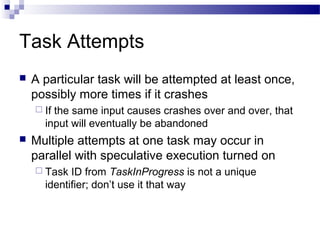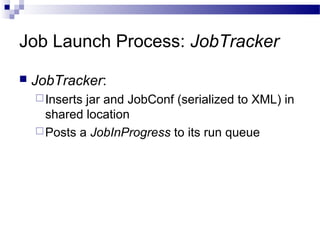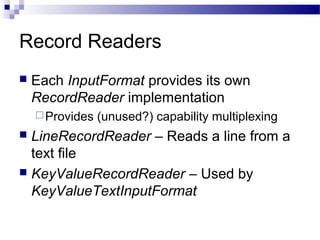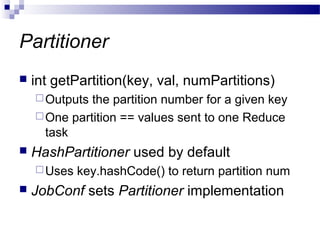Hadoop 3
- 1. Lecture 3 – Hadoop Technical Introduction CSE 490H
- 2. Announcements My office hours: M 2:30—3:30 in CSE 212 Cluster is operational; instructions in assignment 1 heavily rewritten Eclipse plugin is “deprecated” Students who already created accounts: let me know if you have trouble
- 3. Breaking news! Hadoop tested on 4,000 node cluster 32K cores (8 / node) 16 PB raw storage (4 x 1 TB disk / node) (about 5 PB usable storage) http://developer.yahoo.com/blogs/hadoop/2008/09/ scaling_hadoop_to_4000_nodes_a.html
- 4. You Say, “tomato…” Google calls it: Hadoop equivalent: MapReduce Hadoop GFS HDFS Bigtable HBase Chubby Zookeeper
- 5. Some MapReduce Terminology Job – A “full program” - an execution of a Mapper and Reducer across a data set Task – An execution of a Mapper or a Reducer on a slice of data a.k.a. Task-In-Progress (TIP) Task Attempt – A particular instance of an attempt to execute a task on a machine
- 6. Terminology Example Running “Word Count” across 20 files is one job 20 files to be mapped imply 20 map tasks + some number of reduce tasks At least 20 map task attempts will be performed… more if a machine crashes, etc.
- 7. Task Attempts A particular task will be attempted at least once, possibly more times if it crashes If the same input causes crashes over and over, that input will eventually be abandoned Multiple attempts at one task may occur in parallel with speculative execution turned on Task ID from TaskInProgress is not a unique identifier; don’t use it that way
- 9. Node-to-Node Communication Hadoop uses its own RPC protocol All communication begins in slave nodes Prevents circular-wait deadlock Slaves periodically poll for “status” message Classes must provide explicit serialization
- 10. Nodes, Trackers, Tasks Master node runs JobTracker instance, which accepts Job requests from clients TaskTracker instances run on slave nodes TaskTracker forks separate Java process for task instances
- 11. Job Distribution MapReduce programs are contained in a Java “jar” file + an XML file containing serialized program configuration options Running a MapReduce job places these files into the HDFS and notifies TaskTrackers where to retrieve the relevant program code … Where’s the data distribution?
- 12. Data Distribution Implicit in design of MapReduce! All mappers are equivalent; so map whatever data is local to a particular node in HDFS If lots of data does happen to pile up on the same node, nearby nodes will map instead Data transfer is handled implicitly by HDFS
- 13. Configuring With JobConf MR Programs have many configurable options JobConf objects hold (key, value) components mapping String ’a e.g., “mapred.map.tasks” 20 JobConf is serialized and distributed before running the job Objects implementing JobConfigurable can retrieve elements from a JobConf
- 14. What Happens In MapReduce? Depth First
- 15. Job Launch Process: Client Client program creates a JobConf Identify classes implementing Mapper and Reducer interfaces JobConf.setMapperClass(), setReducerClass() Specify inputs, outputs FileInputFormat.addInputPath(), FileOutputFormat.setOutputPath() Optionally, other options too: JobConf.setNumReduceTasks(), JobConf.setOutputFormat()…
- 16. Job Launch Process: JobClient Pass JobConf to JobClient.runJob() or submitJob() runJob() blocks, submitJob() does not JobClient: Determines proper division of input into InputSplits Sends job data to master JobTracker server
- 17. Job Launch Process: JobTracker JobTracker: Inserts jar and JobConf (serialized to XML) in shared location Posts a JobInProgress to its run queue
- 18. Job Launch Process: TaskTracker TaskTrackers running on slave nodes periodically query JobTracker for work Retrieve job-specific jar and config Launch task in separate instance of Java main() is provided by Hadoop
- 19. Job Launch Process: Task TaskTracker.Child.main(): Sets up the child TaskInProgress attempt Reads XML configuration Connects back to necessary MapReduce components via RPC Uses TaskRunner to launch user process
- 20. Job Launch Process: TaskRunner TaskRunner, MapTaskRunner, MapRunner work in a daisy-chain to launch your Mapper Task knows ahead of time which InputSplits it should be mapping Calls Mapper once for each record retrieved from the InputSplit Running the Reducer is much the same
- 21. Creating the Mapper You provide the instance of Mapper Should extend MapReduceBase One instance of your Mapper is initialized by the MapTaskRunner for a TaskInProgress Exists in separate process from all other instances of Mapper – no data sharing!
- 22. Mapper void map(K1 key, V1 value, OutputCollector<K2, V2> output, Reporter reporter) K types implement WritableComparable V types implement Writable
- 23. What is Writable? Hadoop defines its own “box” classes for strings (Text), integers (IntWritable), etc. All values are instances of Writable All keys are instances of WritableComparable
- 24. Getting Data To The Mapper
- 25. Reading Data Data sets are specified by InputFormats Defines input data (e.g., a directory) Identifies partitions of the data that form an InputSplit Factory for RecordReader objects to extract (k, v) records from the input source
- 26. FileInputFormat and Friends TextInputFormat – Treats each ‘n’- terminated line of a file as a value KeyValueTextInputFormat – Maps ‘n’- terminated text lines of “k SEP v” SequenceFileInputFormat – Binary file of (k, v) pairs with some add’l metadata SequenceFileAsTextInputFormat – Same, but maps (k.toString(), v.toString())
- 27. Filtering File Inputs FileInputFormat will read all files out of a specified directory and send them to the mapper Delegates filtering this file list to a method subclasses may override e.g., Create your own “xyzFileInputFormat” to read *.xyz from directory list
- 28. Record Readers Each InputFormat provides its own RecordReader implementation Provides (unused?) capability multiplexing LineRecordReader – Reads a line from a text file KeyValueRecordReader – Used by KeyValueTextInputFormat
- 29. Input Split Size FileInputFormat will divide large files into chunks Exact size controlled by mapred.min.split.size RecordReaders receive file, offset, and length of chunk Custom InputFormat implementations may override split size – e.g., “NeverChunkFile”
- 30. Sending Data To Reducers Map function receives OutputCollector object OutputCollector.collect() takes (k, v) elements Any (WritableComparable, Writable) can be used By default, mapper output type assumed to be same as reducer output type
- 31. WritableComparator Compares WritableComparable data Will call WritableComparable.compare() Can provide fast path for serialized data JobConf.setOutputValueGroupingComparator()
- 32. Sending Data To The Client Reporter object sent to Mapper allows simple asynchronous feedback incrCounter(Enum key, long amount) setStatus(String msg) Allows self-identification of input InputSplit getInputSplit()
- 34. Partitioner int getPartition(key, val, numPartitions) Outputs the partition number for a given key One partition == values sent to one Reduce task HashPartitioner used by default Uses key.hashCode() to return partition num JobConf sets Partitioner implementation
- 35. Reduction reduce( K2 key, Iterator<V2> values, OutputCollector<K3, V3> output, Reporter reporter) Keys & values sent to one partition all go to the same reduce task Calls are sorted by key – “earlier” keys are reduced and output before “later” keys
- 36. Finally: Writing The Output
- 37. OutputFormat Analogous to InputFormat TextOutputFormat – Writes “key valn” strings to output file SequenceFileOutputFormat – Uses a binary format to pack (k, v) pairs NullOutputFormat – Discards output
- 38. Questions?





































